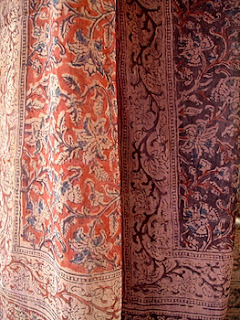Kalamkari is a type of hand-painted or block-printed cotton textile, produced in parts of India. The word is derived from the Persian words kalam (pen) and kari (craftmanship), meaning drawing with a pen.
The craft made at Machilipatnam in Andhra Pradesh, evolved with patronage of the Mughals and the Golconda sultanate.
There are two distinctive styles of kalamkari art in India - one, the Srikalahasti style and the other, the Machalipatnam style of art. The Srikalahasti style of Kalamkari, wherein the "kalam" or pen is used for free hand drawing of the subject and filling in the colours, is entirely hand worked. This style depicted deities and scenes taken from the great Hindu epics - Ramayana. Mahabarata, Puranas and the mythological classics.
Only natural dyes are used in Kalamkari and it involves seventeen painstaking steps. The cotton fabric gets its glossiness by immersing it for an hour in a mixture of myrabalam (resin) and cow milk. Contours and reasons are then drawn with a point in bamboo soaked in a mixture of jagri fermented and water; one by one these are applied, then the vegetable dyes. After applying each color, the Kalamkari is washed. Thus, each fabric can undergo up to 20 washings. Various effects are obtained by using cow dung, seeds, plants and crushed flowers.The J. J. School of Art, Mumbai is one such beneficiary. They are presently experimenting with this art form on Silk Ikat (i.e., tie and dye textiles popular in Pochampally, Andhra Pradesh).






Thanks for the history and the photos! Very helpful.
ReplyDeleteWelcome :) Hope it has full filled your needs
ReplyDeleteYou can also have a look at my other blog posts related to Lifestyle!
ReplyDelete